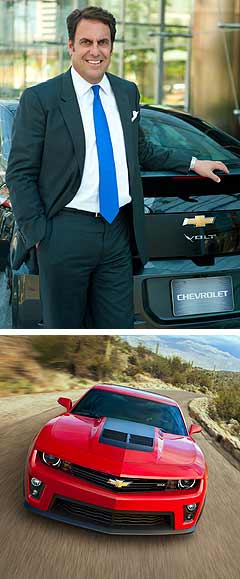News - Holden - CommodoreGeneral Motors boss defends Aussie ‘orphan’Rolling on: Holden's Zeta-based Commodore could continue long-term provided sales numbers demand the local large car. Zeta platform still relevant despite Holden’s global shift post-VF model, says Reuss9 Apr 2012 By MARK FOGARTY in NEW YORK HOLDEN’S orphaned Zeta large-car architecture still figures in General Motors’ global platform strategy, although its long-term future depends on maintaining sustainable volumes of Commodore-based exports from Australia. Zeta’s place within GM’s rapid rationalisation of vehicles worldwide has been defended by the recovering auto giant’s North America president – and former GM Holden chief – Mark Reuss, who was adamant it was a global platform despite its limited application. Speaking to GoAuto News at the New York International Auto Show, Mr Reuss also asserted that Holden’s unique Zeta rear-drive sedan architecture would continue as long as local and export sales supported it. “It’s still a global rear-wheel drive architecture, so we leverage it on Camaro, we do lots of things,” he said. “I mean, you guys (Holden) still export things. There’s all that. “I’m not sure that changes unless the market tells us to change it. If the market tells us to change it, we’ll change it.” Mr Reuss, the former managing director and chairman of GM Holden who was promoted to run the reorganised parent company’s North American operations at the end of 2009, claimed he could not predict if the Commodore’s Zeta platform had a long future. “I don’t know because the volume comes out of Australia, so you’d know the Australian economy more than I do right now,” he said. “And if the economy says that we’re going to keep making it, we’ll keep making it.”  Left: GM president Mark Reuss Chevrolet Camaro ZL1. Left: GM president Mark Reuss Chevrolet Camaro ZL1.Although Fishermans Bend was proclaimed as GM’s ‘home room’ for the design of rear-drive models, the only spin-off from Holden’s $1 billion development of the Zeta platform has been the reborn Chevrolet Camaro, which uses a modified Commodore architecture known as Zeta II. Mr Reuss, who has championed the Commodore’s return to the North American market as a Chevrolet V8 performance sedan, was defensive about the status of the underutilised Zeta platform during a hurried on-the-move conversation. To the contention that it was not a truly global platform, being made in only two locations primarily for local markets, he retorted: “Well, I don’t know. Zeta II, ah Camaros, are sold all over the world.” He also bristled at the suggestion that the Camaro was a niche model: “I don’t know, we’re kicking ass with it.” Mr Reuss maintained it did not matter that Zeta was not a high-volume global platform like Delta II, Epsilon II and Super Epsilon II, which underpin GM’s small, mid-size and latest large car models respectively. “No, but so what?” he said. “I don’t care as long as… We’ve already paid for it, it’s all done.” Once touted as spawning a global range of Commodore-based rear-drive sedans, the conventional wisdom is that the Zeta platform was sidelined during GM’s descent into Chapter 11 bankruptcy in 2009. But in a thinly veiled criticism of his Holden predecessors, Zeta architect Peter Hanenberger and Denny Mooney, who presided over the launch of the VE Commodore, Mr Reuss disputed the scope of the program. “There was a whole bunch of stuff before I was there,” he said. “You know, before I got there, this was way oversold and (it was) really strange what was going on in terms of running a business and making architecture and car platform decisions, I’ll tell you that right now. “Whoever was selling this oversold the hell out of it.” Before the twin blows of the GFC and the surge in the value of Australian dollar, Elizabeth-built left-hand drive VE Commodores and WM long-wheelbase versions were sold in their tens of thousands in the US (as the Pontiac G8) and the Middle East (as the Chevrolet Lumina and Caprice). Chevrolet-badged Caprices are exported in limited quantities to the Middle East and US, while a trickle of Caprice-based Buick Park Avenues are sent in CKD form to China. Holden has admitted that the specialist, but potentially high-volume, Chevrolet Police Patrol Vehicle (PPV) program into North America is also struggling. There is widespread speculation in the US that next year’s major VF Commodore upgrade will form the basis of a new Chevrolet SS rear-drive performance sedan. According to multiple US industry sources, the Zeta architecture no longer figures in future GM large rear-wheel drive sedan planning, replaced by an extension of the Alpha platform introduced with the new BMW 3-Series-rivalling Cadillac ATS. Alpha is also tipped to be the base of the next, sixth-generation Camaro, further indicating that Zeta will be left out in the cold. Ironically, the Alpha platform is a Detroit development of the cutdown Zeta chassis designed by Holden for the mid-size Torana TT36 concept shown in 2004. As GoAuto has reported, Holden has committed to a billion-dollar, 10-year local manufacturing program based on two all-new next-generation global vehicle architectures. In announcing the plan last month, current Holden chief Mike Devereux made it clear that the Zeta platform underpinning Commodore “is not a global architecture per se” whereas the two new platforms to be built in Adelaide in the second half of the decade – one of which is expected to be the Delta-based Cruze – would be “built off global GM platforms”.  Read more |
Click to shareHolden articlesCommodore pricing
Motor industry news |















Facebook Twitter Instagram